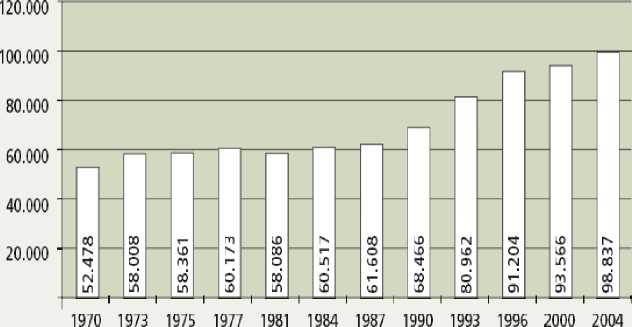16
Services and Facilities of the Voluntary
WelfareAssociations 1970 - 2004
—
Establishments

As regards the shares of the voluntary welfare associations of the whole welfare market
they dominate in providing nursing homes, youth support and support for persons with
disabilities:39
Shares of the Voluntary WelfareAssociations in %
(Boeβenecker 2007)
|
Establish- |
Year |
Voluntary |
Private, |
Public |
|
In o∕o |
In o∕o |
In o∕o | ||
|
— | ||||
|
Hospitals |
2001 |
40,3 |
23,5 |
36,2 |
|
Prevention/ |
2001 |
26,5 |
≡7,8 |
15,7 |
|
Rehabilit. | ||||
|
Nursing |
2001 |
56,0 |
35,9 |
8,2 |
|
Homes | ||||
|
Nursing |
2001 |
46,2 |
≡1,9 |
1,9 |
|
Services | ||||
|
Youth support |
2002 |
62,2 |
28,6 |
9,2 |
|
Kindergarten |
2002 |
48,9 |
10,7 |
40,4 |
|
Support for |
2001 |
83,9 |
10,8 |
5,4 |
|
disabled |
_ |
More than 1.4 million persons are employed by the voluntary welfare associations:40
39 Boeβenecker 2007: 7.
40 BAGFW 2004:15.
More intriguing information
1. The name is absent2. Studies on association of arbuscular mycorrhizal fungi with gluconacetobacter diazotrophicus and its effect on improvement of sorghum bicolor (L.)
3. Who runs the IFIs?
4. The name is absent
5. The name is absent
6. The name is absent
7. What should educational research do, and how should it do it? A response to “Will a clinical approach make educational research more relevant to practice” by Jacquelien Bulterman-Bos
8. Assessing Economic Complexity with Input-Output Based Measures
9. EXECUTIVE SUMMARY
10. How to do things without words: Infants, utterance-activity and distributed cognition.